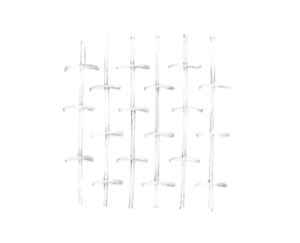The most basic weave, we are first taught plain weaving as schoolchildren with ribbons or paper tapes: the vertical warp yarns and horizontal weft yarns are woven in alternate over-and-under passes, thus creating a simple criss-cross pattern fabric. Also called tabby, linen or taffeta weave; it produces a strong and hard-wearing cloth with identical sides.
With plain weaves, unless there is supplementary treatment to the woven cloth the back and the front are exactly the same, so that it can be turned and twisted to no ill effect. Being fully reversible with no pile makes all plain weaves easy to manage and economical to work with both in terms of time spent and fabric used.
On a weaving loom, the warp threads are first tied vertically into the top and bottom of the loom, which means the weft (in a shuttle) will pass through horizontally: over one warp thread, under the next, and so on. At the last warp thread, the weft loops around it and returns, repeating the same over-and-under weaving. Each pass through of the shuttle is called the pick.
* There are only three core weaves – plain weave, satin and twill, which by combination of design creates all other weaves. The loom functions in such a way that it opens out to separate the warp threads into whatever sequence the design requires, in variations of these.
* Plain weaves have the capacity to produce the very highest density cloths with high abrasion resistance and resistance to yarn slippage.
* The thread count depends on the yarn density and how closely the warps have been tied and how many picks per square cm or inch.
* The appearance and the use of the finished cloth is determined by the quality and type of thread: smooth, rough, shiny, matte, plain, coloured..
* Plain woven fabrics will either be used in their own right, or become the base cloth, or ground cloth, for all other manners of finishes and printing.
* Amongst many plain weave fabrics are: calico, canvas, lawn, poplin, gingham; shantung, habotai, taffeta, melton, flannel, and most linen, jute, and hemp cloths are plain weaves. Union, often called linen union, cotton union or metis, is the classic plain weave combination of two fibres to gain the properties of both.

